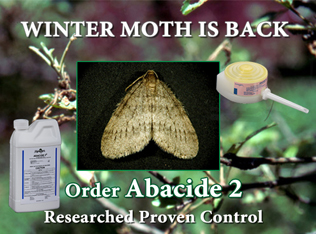 Winter Moth (Operophtera brumata) larvae can defoliate host plants. Mortality is high for host plants defoliated two or more years in a row.
Winter Moth (Operophtera brumata) larvae can defoliate host plants. Mortality is high for host plants defoliated two or more years in a row.
Winter moth has been established in Massachusetts, Rhode Island and has been found in New Hampshire, coastal Maine, south eastern Connecticut, Long Island, NY., Washington, Oregon, Eastern Canada on Prince Edward Island, Western Canada, Vancouver, British Columbia, New Brunswick, Nova Scotia and has been spreading where conditions favor.
Host trees include:
Acer, Amelanchier, Betula, Calluna, Carpinus, Castanea, Corylus, Crataegus – Cydonia, Fagus, Fraxinus, Larix Malus, Myrica, Ostrya, Picea, Populus, Prunus, Pyrus, Quercus, Rhamnus, Rhododendron, Ribes, Rosa, Rubus, Salix, Sorbus, Tilia , Ulmus, Vaccinium and Viburnum.
Winter moth was introduced into North America from Europe.
The first infestations were confirmed in Nova Scotia in the 1930’s.
The newly hatched larvae crawl up tree trunks and disperse by ballooning on a silken strand. Larvae work themselves underneath the scales of flower and leaf buds where they begin to feed from within, completely destroying the buds. They move into new buds until the clusters start to open. During cool wet springs the damage to buds may be extensive. As the leaf buds open the small larvae cluster in the new leaves. The larvae leave the leaf clusters to feed at night.
A study conducted by Robin Spitco Ph.D. in New England (2007 and 2008) conclude that Mauget’s Abacide 2, Abacide 2 Hp and Inject-a-cide B provided excellent control.

